
Sep 4
Young Sheldon Star Raegan Revord Comes Out as Non-Binary
READ TIME: 3 MIN.
Raegan Revord, best known for their acclaimed performance as Missy Cooper in the CBS series Young Sheldon, has come out as non-binary, joining a growing movement of young celebrities advocating for greater LGBTQ+ visibility and acceptance in mainstream entertainment. At just 17 years old, Revord’s announcement has resonated widely, sparking conversations about gender identity and authentic self-expression in Hollywood and beyond .
Revord first shared their non-binary identity publicly at the start of 2025, affirming their use of they/them pronouns and crediting gender-fluid celebrities for inspiring their journey. In interviews, Revord has discussed how living authentically has been both a personal liberation and a public responsibility. “It’s so cool,” Revord stated, referencing the sense of freedom and pride that has come with embracing their true self . For years, Revord had quietly used they/them pronouns in private circles, but chose to make their identity public in January 2025, a decision they described as empowering and necessary for self-acceptance .
The actor’s announcement quickly garnered support from fans, fellow cast members, and LGBTQ+ advocacy organizations. Many praised Revord for their courage and highlighted the importance of visibility for young queer and non-binary people—particularly in the entertainment industry, where representation remains crucial for challenging stereotypes and promoting acceptance .
Revord’s career has spanned from early childhood roles to their breakout performance on Young Sheldon, where they became a fan favorite for their nuanced portrayal of Missy Cooper. Raised in Los Angeles after being born in San Diego, Revord has been vocal about their experiences growing up in the public eye and the challenges that come with balancing personal identity with professional demands .
In addition to their acting career, Revord has recently released a debut novel, "Rules for Fake Girlfriends," which features a queer love story—a testament to their commitment to inclusive storytelling and representation. Revord described the book as a celebration of queer identities and relationships, aiming to create authentic narratives for young readers who may be seeking affirmation and understanding in popular media .
Their work as a junior ambassador for Children’s Hospital Los Angeles further underscores their dedication to advocacy and social impact, using their platform to champion causes close to their heart, including LGBTQ+ rights and youth empowerment .
Revord’s coming out has been met with celebration within LGBTQ+ communities and organizations, who see their openness as a milestone for non-binary representation in mainstream television. As more public figures embrace diverse gender identities, advocates stress the importance of affirming language, inclusive storytelling, and safe spaces for queer youth.
Experts in gender studies and LGBTQ+ advocacy note that visibility in entertainment can play a critical role in shaping public attitudes and policy. Revord joins a wave of young actors and artists—such as Hunter Schafer, Lachlan Watson, and Emma D’Arcy—whose openness has helped expand conversations around gender, identity, and acceptance . Advocacy groups, including GLAAD and the Human Rights Campaign, have issued statements of support, emphasizing the impact of Revord’s announcement on young people who may feel unseen or unsupported in their own journeys.
“Every time a young person in the public eye comes out, it sends a powerful message that being authentic is not only possible but celebrated,” said a spokesperson for the Human Rights Campaign, highlighting the ripple effect such visibility can have on families, schools, and communities .
While Revord’s announcement has been largely met with positivity, they have also addressed the complexities of navigating gender identity as a public figure. In recent interviews, Revord acknowledged the pressures of social media scrutiny and the need for supportive environments, both online and offline. They emphasized the importance of mental health resources and community support for non-binary and transgender people, particularly those in high-visibility roles .
As Revord continues to pursue new creative projects and advocacy work, they serve as a role model for young people navigating questions of identity and belonging. Their openness challenges outdated norms and encourages audiences—regardless of gender—to embrace the diversity and richness of human experience.
For LGBTQ+ communities, allies, and advocates, Revord’s journey is a call to action: to listen, uplift, and celebrate every individual’s right to live as their authentic self.






